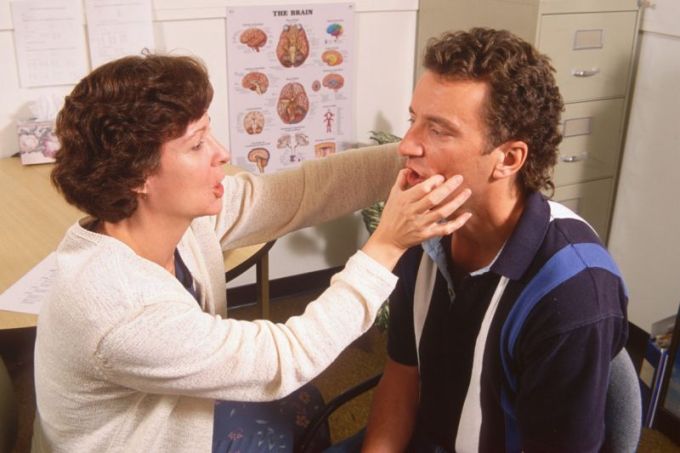Apraxia of Speech (AOS) has been defined as an alteration of the programming speech with difficulty initiating speech, slow articulation and varying distortion of phonemes.
In other words, people with Apraxia of Speech can know exactly what they want to say, but at the time of pronouncing they do not remember how they should put the orofacial organs into operation in order to emit each sound that composes it.
It is a complex problem and, although there may be people with pure apraxia of speech, in most cases this pathology is accompanied by aphasia.
Apraxia of Speech Causes
It is an acquired disorder of neurological origin that results from a lesion in the left hemisphere. More specifically, it seems to be the result of an injury in the third frontal convolution of the dominant hemisphere, in the region of Broca’s area.
It can coexist with oral apraxia, difficulty in performing oral movements by order and imitation; dysarthria, speech impairment due to difficulty mobilizing the fonoarticulatory organs and/or aphasia, language disorder. However, apraxia of speech cannot be explained by any of these alterations.
The most common cause is vascular etiology (stroke, cerebral aneurysm, cerebral infarction, cerebral hemorrhages), but apraxia of speech can also be caused by:
- Tumors
- Cranioencephalic trauma
- Infections
Likewise, it can be a symptom in neurodegenerative diseases such as corticobasal degeneration or progressive supranuclear palsy.
In some cases, it is the only sign, or the most prominent, of a neurodegenerative picture. In these cases, the term used is primary progressive apraxia of speech.
Apraxia of Speech Characteristics
Speech, in apraxic patients, is altered in three aspects mainly:
Joint
- Substitutions, additions, distortions and repetitions of phonemes occur. Some substitutions are in advance and/or by regression.
- Bilabial and alveolar have fewer errors.
- Africans and fricatives present more errors.
- Greater difficulty in symphonies.
- Errors and distortions of vowels.
- Less difficulty in vowels than in consonants.
- Less difficulty in words with meaning.
- Greater difficulty into the length of the word.
- Greater difficulty in intentional than in automatic sentences.
- Errors occur in both spontaneous and imitative speech.
- Aware of their articulatory errors.
- The position within the word does not influence.
Speed and prosody
- Slower speed in productions of more than one syllable.
- Prolongation of consonants and vowels.
- Pauses at the beginning, between syllables and between words.
- Dysprosody.
- Difficulty varying the accent in spontaneous speech.
- The alteration in prosody gives the impression of a foreign accent.
Fluency
- Repetitive attempts at articulation starts to say words.
- Repetitions of sounds and syllables.
- Visible and auditory essay efforts – error for the articulatory postures at the beginning of the sentences.
In higher degrees of severity in apraxia, speech may be characterized by presenting:
- Limited repertoire of phonemes.
- Speech may be limited to a few meaningless and unintelligible phrases.
- The imitation of isolated sounds can be wrong.
- Automatic speech is not better than spontaneous speech.
- Mutism.
- Accompanied by severe aphasia.
- Accompanied by non-verbal oral apraxia.
Apraxia of Speech Evaluation
There are different tests that help us to evaluate apraxia of speech and establish a diagnosis.
Diagnosis is important, on the one hand, to differentiate it from other conditions that affect communication and, on the other, to establish an adequate approach from the therapeutic point of view, since the treatment is very different from that applied in a dysarthria or in aphasia.
Apraxia of Speech Treatment
The objectives of the treatment are established according to the degree of severity of the apraxia in each patient. In optimal conditions, in which the prognosis is favorable, the main objective is:
- Getting the patient to consciously control the articulatory programming so that the speech can be produced voluntarily. The objective of the treatment is to ensure that the patient can communicate efficiently.
- A specific objective for this disorder is to restore as much as possible the patient’s speech (only for those patients that the prognosis is favorable). The goal is not normal speech but functional speech.
The main objectives of the rehabilitation are:
- In the acute stage, achieve efficient functional communication, using for example alternative strategies.
- In the chronic stage, when oral production is possible, achieve functional speech. This may vary depending on the type, severity and coexistence of other alterations that the patient presents.
There are different strategies to treat patients with apraxia of speech being the most used collision of the joint. For severe apraxia, alternative or augmentative communication techniques may be necessary. The patient’s family plays an important role in the treatment of apraxia of speech.
